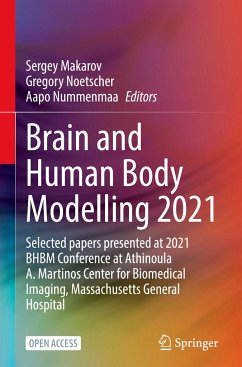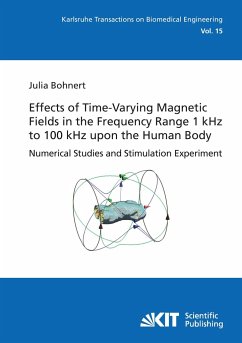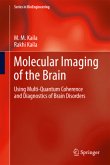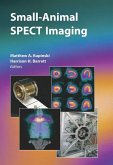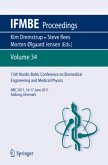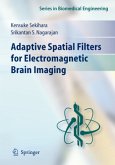Brain and Human Body Modelling 2021
Selected papers presented at 2021 BHBM Conference at Athinoula A. Martinos Center for Biomedical Imaging, Massachusetts General Hospital
Herausgeber: Makarov, Sergey; Noetscher, Gregory; Nummenmaa, Aapo
Brain and Human Body Modelling 2021
Selected papers presented at 2021 BHBM Conference at Athinoula A. Martinos Center for Biomedical Imaging, Massachusetts General Hospital
Herausgeber: Makarov, Sergey; Noetscher, Gregory; Nummenmaa, Aapo
- Gebundenes Buch
- Merkliste
- Auf die Merkliste
- Bewerten Bewerten
- Teilen
- Produkt teilen
- Produkterinnerung
- Produkterinnerung
This open access book describes modern applications of computational human modelling to advance neurology, cancer treatment, and radio-frequency studies including regulatory, safety, and wireless communication fields. Readers working on any application that may expose human subjects to electromagnetic radiation will benefit from this book¿s coverage of the latest models and techniques available to assess a given technology¿s safety and efficacy in a timely and efficient manner. This is an Open Access book.
![Brain and Human Body Modelling 2021 Brain and Human Body Modelling 2021]() Brain and Human Body Modelling 202131,99 €
Brain and Human Body Modelling 202131,99 €![Effects of Time-Varying Magnetic Fields in the Frequency Range 1 kHz to 100 kHz upon the Human Body : Numerical Studies and Stimulation Experiment Effects of Time-Varying Magnetic Fields in the Frequency Range 1 kHz to 100 kHz upon the Human Body : Numerical Studies and Stimulation Experiment]() Julia BohnertEffects of Time-Varying Magnetic Fields in the Frequency Range 1 kHz to 100 kHz upon the Human Body : Numerical Studies and Stimulation Experiment45,00 €
Julia BohnertEffects of Time-Varying Magnetic Fields in the Frequency Range 1 kHz to 100 kHz upon the Human Body : Numerical Studies and Stimulation Experiment45,00 €![Molecular Imaging of the Brain Molecular Imaging of the Brain]() M. M. KailaMolecular Imaging of the Brain110,99 €
M. M. KailaMolecular Imaging of the Brain110,99 €![Small-Animal SPECT Imaging Small-Animal SPECT Imaging]() Small-Animal SPECT Imaging161,99 €
Small-Animal SPECT Imaging161,99 €![Adaptive Spatial Filters for Electromagnetic Brain Imaging Adaptive Spatial Filters for Electromagnetic Brain Imaging]() Kensuke SekiharaAdaptive Spatial Filters for Electromagnetic Brain Imaging110,99 €
Kensuke SekiharaAdaptive Spatial Filters for Electromagnetic Brain Imaging110,99 €![15th Nordic-Baltic Conference on Biomedical Engineering and Medical Physics 15th Nordic-Baltic Conference on Biomedical Engineering and Medical Physics]() 15th Nordic-Baltic Conference on Biomedical Engineering and Medical Physics116,99 €
15th Nordic-Baltic Conference on Biomedical Engineering and Medical Physics116,99 €![Adaptive Spatial Filters for Electromagnetic Brain Imaging Adaptive Spatial Filters for Electromagnetic Brain Imaging]() Kensuke SekiharaAdaptive Spatial Filters for Electromagnetic Brain Imaging110,99 €
Kensuke SekiharaAdaptive Spatial Filters for Electromagnetic Brain Imaging110,99 €-
-
-
- Produktdetails
- Verlag: Springer International Publishing
- 1st ed. 2023
- Seitenzahl: 180
- Erscheinungstermin: 30. November 2022
- Englisch
- Abmessung: 241mm x 160mm x 16mm
- Gewicht: 442g
- ISBN-13: 9783031154508
- ISBN-10: 3031154509
- Artikelnr.: 64545581
- Verlag: Springer International Publishing
- 1st ed. 2023
- Seitenzahl: 180
- Erscheinungstermin: 30. November 2022
- Englisch
- Abmessung: 241mm x 160mm x 16mm
- Gewicht: 442g
- ISBN-13: 9783031154508
- ISBN-10: 3031154509
- Artikelnr.: 64545581
Treating Fields.- 1. Nichal Gentilal, Ariel Naveh, Tal Marciano, Zeev
Bomzon, Yevgeniy Telepinsky, Yoram Wasserman, and Pedro Cavaleiro Miranda.
The impact of scalp's temperature in the predicted LMiPD in the tumor
during TTFields treatment for glioblastoma multiforme.- 2. N. Mikic,
F. Cao, F.L. Hansen, A.M. Jakobsen, A. Thielscher, and A.R. Korshøj.
Standardizing skullremodeling surgery and electrode array layout to improve
Tumor Treating Fields using computational head modeling and finite element
methods.- Part 2 Low Frequency Electromagnetic Modeling and Experiment.
Neural Stimulation in Gradient Coils.- 3. Yihe Hua, Desmond T.B. Yeo,
and Thomas KF Foo. Peripheral Nerve Stimulation (PNS) Analysis of MRI Head
Gradient Coils with Human Body Models.- Part 3 Low Frequency
ElectromagneticModeling and Experiment. Transcranial Magnetic
Stimulation.- 4. Mohammad Daneshzand, Lucia I. Navarro de Lara,
Qinglei Meng, Sergey N. Makarov, Tommi Raij, and Aapo Nummenmaa.
Experimental verification of a computational real-time neuronavigation
system for multichannel Transcranial Magnetic Stimulation.- 5. Tayeb
Zaidi and Kyoko Fujimoto. Evaluation and Comparison of Simulated Electric
Field Differences Using Three Image Segmentation Methods for TMS.- 6.
Qinglei Meng, Hedyeh Bagherzadeh, Elliot Hong, Yihong Yang, Hanbing Lu,
Fow-Sen Choa. Angle-tuned Coil: A Focality-Adjustable Transcranial Magnetic
Stimulator.- Part 4 Low Frequency Electromagnetic Modeling and Experiment.
Spinal Cord Stimulation.- 7. Sofia R. Fernandes, Mariana Pereira,
Sherif M. Elbasiouny, Yasin Y. Dhaher, Mamede de Carvalho, and Pedro C.
Miranda. Interplay between Electrical Conductivity of Tissues and Position
of Electrodes in Transcutaneous Spinal Direct Current Stimulation
(tsDCS).- Part 5 High Frequency Electromagnetic Modeling and Experiment.
MRI Safety with Active and Passive Implants.- 8. James E. Brown, Paul
J. Stadnik, Jeffrey A. Von Arx, and Dirk Muessig. RF-induced Heating Near
Active Implanted Medical Devices in MRI: Impact of Tissue Simulating
Medium.- 9. Gregory M Noetscher, Peter Serano, Ara Nazarian, Sergey N
Makarov. Computational Tool Comprising Visible Human Project® Based
Anatomical Female CAD Model and Ansys HFSS/Mechanical® FEM Software for
Temperature Rise Prediction near an Orthopedic Femoral Nail Implant during
a 1.5 T MRI Scan.- Part 6 High Frequency Electromagnetic Modeling.
Microwave Imaging.- 10. Peter Serano, Johnathan Adams, Ara Nazarian.
Modeling and Experimental Results for Microwave Imaging of a Hip with
Emphasis on the Femoral Neck.
Treating Fields.- 1. Nichal Gentilal, Ariel Naveh, Tal Marciano, Zeev
Bomzon, Yevgeniy Telepinsky, Yoram Wasserman, and Pedro Cavaleiro Miranda.
The impact of scalp's temperature in the predicted LMiPD in the tumor
during TTFields treatment for glioblastoma multiforme.- 2. N. Mikic,
F. Cao, F.L. Hansen, A.M. Jakobsen, A. Thielscher, and A.R. Korshøj.
Standardizing skullremodeling surgery and electrode array layout to improve
Tumor Treating Fields using computational head modeling and finite element
methods.- Part 2 Low Frequency Electromagnetic Modeling and Experiment.
Neural Stimulation in Gradient Coils.- 3. Yihe Hua, Desmond T.B. Yeo,
and Thomas KF Foo. Peripheral Nerve Stimulation (PNS) Analysis of MRI Head
Gradient Coils with Human Body Models.- Part 3 Low Frequency
ElectromagneticModeling and Experiment. Transcranial Magnetic
Stimulation.- 4. Mohammad Daneshzand, Lucia I. Navarro de Lara,
Qinglei Meng, Sergey N. Makarov, Tommi Raij, and Aapo Nummenmaa.
Experimental verification of a computational real-time neuronavigation
system for multichannel Transcranial Magnetic Stimulation.- 5. Tayeb
Zaidi and Kyoko Fujimoto. Evaluation and Comparison of Simulated Electric
Field Differences Using Three Image Segmentation Methods for TMS.- 6.
Qinglei Meng, Hedyeh Bagherzadeh, Elliot Hong, Yihong Yang, Hanbing Lu,
Fow-Sen Choa. Angle-tuned Coil: A Focality-Adjustable Transcranial Magnetic
Stimulator.- Part 4 Low Frequency Electromagnetic Modeling and Experiment.
Spinal Cord Stimulation.- 7. Sofia R. Fernandes, Mariana Pereira,
Sherif M. Elbasiouny, Yasin Y. Dhaher, Mamede de Carvalho, and Pedro C.
Miranda. Interplay between Electrical Conductivity of Tissues and Position
of Electrodes in Transcutaneous Spinal Direct Current Stimulation
(tsDCS).- Part 5 High Frequency Electromagnetic Modeling and Experiment.
MRI Safety with Active and Passive Implants.- 8. James E. Brown, Paul
J. Stadnik, Jeffrey A. Von Arx, and Dirk Muessig. RF-induced Heating Near
Active Implanted Medical Devices in MRI: Impact of Tissue Simulating
Medium.- 9. Gregory M Noetscher, Peter Serano, Ara Nazarian, Sergey N
Makarov. Computational Tool Comprising Visible Human Project® Based
Anatomical Female CAD Model and Ansys HFSS/Mechanical® FEM Software for
Temperature Rise Prediction near an Orthopedic Femoral Nail Implant during
a 1.5 T MRI Scan.- Part 6 High Frequency Electromagnetic Modeling.
Microwave Imaging.- 10. Peter Serano, Johnathan Adams, Ara Nazarian.
Modeling and Experimental Results for Microwave Imaging of a Hip with
Emphasis on the Femoral Neck.

